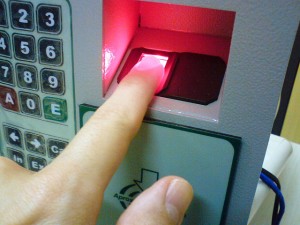 In 1987, seven-year-old Whitney was asked to draw a picture of what she thought the world would look like in the year 2000.
In 1987, seven-year-old Whitney was asked to draw a picture of what she thought the world would look like in the year 2000.
Ohhhhh man, did she have some ideas.
First, she was absolutely positive that we would all be living on the moon. (Yes, in a mere 13 years, the people of the world were going to be able to live on the moon. She had high hopes for our space program.)
Secondly, she was sure flying cars were going to be the transportation of the future.
And finally, she thought that to enter buildings we were all going to have to scan our eyeballs and a computer would open the doors for us. (She’d seen Blade Runner even though she was entirely too young to see such a movie and her mother should have known better.)
Hey, one out of three isn’t terrible.
Security Biometrics in the Movies
Hollywood has been telling us for years that the technology needed to essentially turn our body parts into keys is right around the corner.
Think about how many movies you’ve seen where someone unlocks a door with a quick scan of their eye or fingerprint.
In many of these movies, this technology was only available in the distant future.
In Back to the Future II, the McFlys had fingerprint scanners at their front door. In X-Men, the United States government had Magneto locked up and the only way to gain access to him was for officials to scan their retinas.
Think all the way back to the very first The Terminator in 1984. Arnold would indeed be back and all it took was a facial recognition scan with alien robot technology to transform him into a humanoid robot.
 Security Biometrics in Real Life
Security Biometrics in Real Life
So, have biometrics followed the path Hollywood expected?
While the timeline may have been a bit skewed and didn’t come into play until later than predicted, the actual implementation of the use of biometrics was pretty darn close.
We use biometrics on our iPhones pretty regularly with the fingerprint scanner to unlock our phones, and it’s become common enough that we don’t automatically spaz out anymore and say things such as, “We’re living in the future!” (That might be just me…) And Android users have been used to facial recognition software for years.
For high security facilities, retina scans aren’t out of the question.
Some schools have even begun to use facial recognition technology as a way to increase the security on campus.
The Drawbacks
Because nothing is perfect (aside from my grandmother’s homemade fried apple pies) the use of biometrics in security has its drawbacks.
For one, there is always the possibility of mechanical failure. Things break and biometrics is not immune from that. There’s also the worry of power failure, which could cut the power supply to the security system rendering the system useless. You know what that means: No retinal scans or facial scans or scans of any sort.
These scanners also depend on being able to gather the information from a clear screen. A bit of dust or dirt on the screen can cause the technology to malfunction. If you’re in a hurry, any of these problems could cause an issue with access.
Regardless of where the industry goes with biometrics in security, I’m sure seven-year-old Whitney would be impressed.
Are you all interested in biometrics in the security industry? Do you want one of my grandma’s homemade fried apple pies? Let us know!

Although the article seems little tough for me to understand clearly as it is a very high-level article. The technology is quite familiar to me, but the applications, like you try to explain here, is surprising to me.
However, from the learners’ point of view, the article is really impressive. Thank you very much for your contribution.